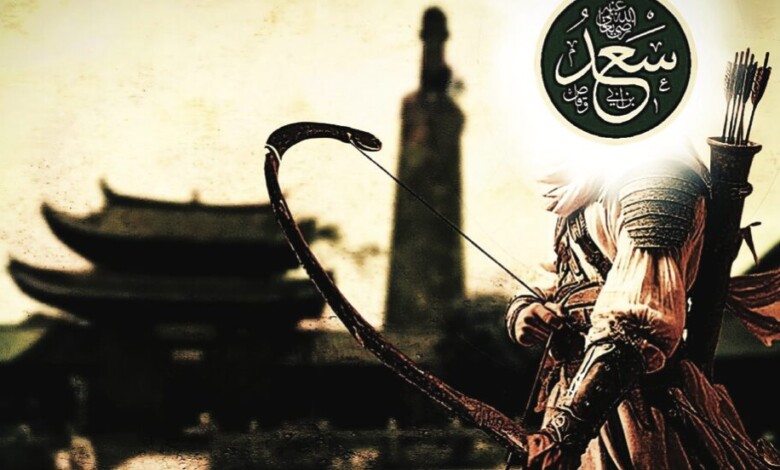Sa’d ibn Abi Waqqas: First to shoot an arrow in Islam’s defense

Sa’d ibn Abi Waqqas belonged to the Banu Zuhrah tribe, which is the same clan as Āminah bint Wahb, the mother of the Prophet Muhammad. The Prophet took pride in this maternal connection. It was reported that once, as the Prophet was sitting with a group of his companions and saw Sa’d approaching, he said to them:
“This is my uncle—let someone show me his uncle!”
Sa’d was born in Mecca, 23 years before the Hijrah (migration to Madinah). He grew up in the Quraysh tribe and worked in arrow-making and crafting bows, a trade that naturally suited a life of archery, hunting, and military raids. He spent much of his time mixing with the youth and elites of Quraysh, learning about the world through interactions with pilgrims coming to Makkah during the Hajj season, each with their own cultures, goals, and perspectives.
The Islam of Sa’d ibn Abi Waqqas
Sa’d ibn Abi Waqqas saw in his dream that he was drowning in a sea. While he was trying to save himself from drowning, he saw the moon. Sa’d tried to reach it, and indeed, he reached it. Then, he saw that Abu Bakr As-Siddiq, Ali ibn Abi Talib, and Zaid ibn Harithah – had preceded him to this moon.
The next morning, he heard that Muhammad was calling to a new religion. He realized that the interpretation of his dream was to embrace the true religion. Sa’d was one of the early converts to Islam. He went to the Prophet while he was in the tribe of Bani Jazima and declared his Islam there. Some say he was the fourth person to embrace Islam, while others say he was the seventh, and Allah knows best.
Migration of Sa’d ibn Abi Waqqas to Madinah
The esteemed companion, Sa’d, was among the first to migrate to the illuminated city of Madinah, arriving before the Messenger of Allah. He migrated alongside the noble companions Ammar ibn Yasir and Bilal ibn Rabah. Their migration followed the migrations of Mus’ab ibn Umair and Abdullah ibn Umm Maktum.
Upon his arrival in Madinah, Sa’d resided in the house of his brother, Utbah ibn Abi Waqqas, who had a house in the city. When the Messenger of Allah reached Madinah, he established a brotherhood between the companions Sa’d ibn Abi Waqqas and Mu’adh ibn Jabal.
The courage of Sa’d ibn Abi Waqqas
Sa’d ibn Abi Waqqas was the first person to shoot an arrow in defense of Islam, which is a clear testament to his bravery. Here are some instances that demonstrate his courage in Islam:
Sa’d ibn Abi Waqqas was one of the knights of the Quraysh who protected the Prophet Muhammad in his battles.
Umar ibn al-Khattab appointed Sa’d ibn Abi Waqqas to lead the campaign against Persia. Through Sa’d’s leadership, the conquest of the Persian lands took place, as well as the victory at the Battle of al-Qadisiyyah.
Sa’d ibn Abi Waqqas’ Retirement from Civil Unrest
Sa’d ibn Abi Waqqas narrated a hadith from the Prophet Muhammad regarding the civil unrest that would occur after the Prophet’s demise. He reported that the Prophet said, “There will be a time of turmoil, and the one who remains seated during it is better than the one who stands, and the one who stands is better than the one who walks, and the one who walks is better than the one who runs. He (the narrator) added, ‘I said, “What is your opinion about the one who is killed?” He said, “He in the cause of his religion, is a martyr; ‘” This hadith highlights the virtue of remaining in seclusion during times of strife.
Sa’d ibn Abi Waqqas chose to stay in seclusion during the civil unrest. His son, Amir, came to him and said, “O my father, why do you not take a leadership role during this turmoil?”
Sa’d replied, “By Allah, I will not accept a leadership position until I am given a sword with which I can strike a believer and the news of it reaches him and he says, ‘May Allah forgive Sa’d!'” He then mentioned that he heard the Prophet say, “Indeed, Allah loves the wealthy, silent, and pious person.
The death of Sa’d ibn Abi Waqqas
Sa’d ibn Abi Waqqas passed away in Al-Aqiq, which is about seven miles from the city of Madinah. This occurred during the caliphate of Muawiya ibn Abi Sufyan in the year 55 AH (After Hijrah).
He was buried in the famous cemetery of Al-Baqi in Madinah, where many other notable companions of the Prophet Muhammad are also buried.


